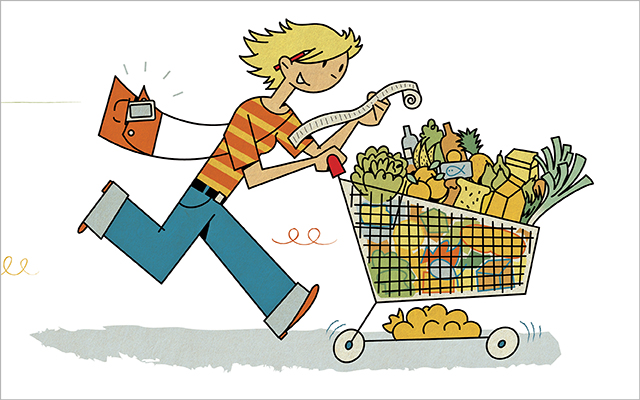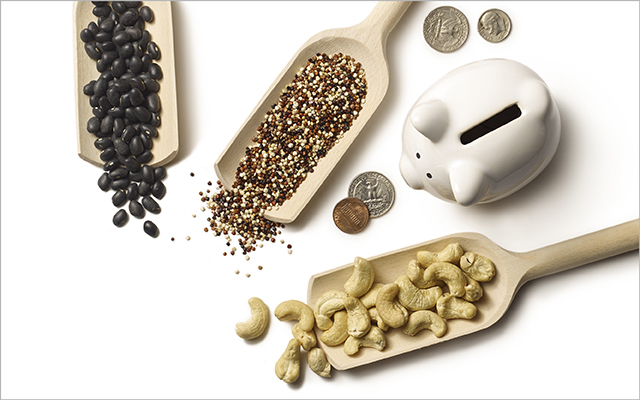Nutritious, whole, organic food can cost a pretty penny, especially if you’re not committed to investing time and energy into becoming a savvy shopper and proactive consumer. I’ve encountered every excuse and complaint in the book and believe me — I hear ya! Family, work and exhaustion are tough demons to tame when you’re staring at an empty dinner table, but let’s face it … Would you rather cut corners and save some money in the short term or spend more time planning, eating consciously, and shopping smart to ward off future hospital bills, prescription costs and long-term health issues? We all slip sometimes and that’s okay! But if you put forth the effort 80 to 90 percent of the time, you’re setting yourself up for increased energy, self-esteem, and happiness for you and your family on a daily basis.
I’m not saying you should run to the nearest health food store and spend your whole paycheck. But before I dive into a bevy of cash saving tips, I’ve got a news flash. This diet and lifestyle wasn’t created for sissies. We’re warriors! That means that you’re not going to see savings unless you stick with the program. It’s time to roll up your sleeves and join this burning hot revolution. Easy-peasy food that you can scarf down in two seconds flat usually equals cheap and unhealthy. Like most things in life, the good stuff takes a little more TLC. I’m not saying that you have to give up your social life, you just might have to cut back on half an hour of Facebook stalking or the latest episode of The Bachelor. A little planning and effort goes a long way.
Now for the dirt. Over the past decade, I’ve been collecting my own tricks of the thrift (I’ve always loved a good haggling), and I’ve picked up loads of cost cutting strategies from my peeps at Crazysexylife.com and my online community posse at my.crazysexylife.com. Please, for the love of unicorns everywhere, add your own killer advice in the comments section. If we keep swapping knowledge, nothing can stop us. Not even 15-dollar raw organic almond butter!
12 Tips to Buying Affordable, Heathy Food
1. Buy bulk. Sure, those bins aren’t as sexy as the pretty packaging on the shelves, but they’re a hell of a lot cheaper! While you’re scooping your millet, get chummy with the grocer and clerks. Your new buddies may be willing to order certain other items in bulk for you. Costco or BJ’s is also a prime destination for large quantity, low cost items.
2. Join your local Community Supported Agriculture (CSA) group. Some may be intimidated by this option because of the commitment and quantity. You’ll usually have a variety of veggies to choose from each week and if a half share is still too much too handle, see if a friend or family member wants to go in on it with you. There’s always the trusty freezer for preserving what you can’t consume that week. Hello strawberries in December! Here are some handy websites: Local Harvest, Biodynamic Farming and Gardening Association, Rodale Institute Farm Locator, Wilson College Database, Eat Well Guide, National Sustainable Agriculture Information Service, and Just Food (NYC Region).
3. Shop your local farmers markets. Take advantage of the local bounty by perusing veggie stands with a critical eye. There are usually a variety of farmers offering an array of prices, so compare prices, bargain and make friends with your favorite farmer. Be open minded about your weekly menu, too. Take advantage of the lower priced veggies and fruits by designing your meals around their deliciousness (they taste even better when they’re a bargain). Find a market near you: Farmers Market, USDA Farmers Market Directory, Farmer’s Market Online and Local Harvest.
4. Budget and plan. Before we even get to the heart of this tip, make sure you aren’t famished when you walk through the entrance of the grocery store or farmers market. That’s the quickest way to derail your well-laid plans to be a smart, healthy shopping minx. Set a comfortable budget for your weekly or bi-weekly shopping excursions and then get to whipping up a list. First, examine your fridge and cupboards. What can you build on? You might start saving right away if you get into this mindset and stop building meals from scratch every time you touch a shopping cart. If planning a whole week’s worth of meals is overwhelming, bite off few days at a time. Need inspiration? Dust off your cookbooks and get creative. You’ll find a list of my go-to recipe books in this Love List.
5. Clean and organize your fridge and cupboards, then stock up on the essentials. The kitchen is no longer a prison. It’s your playground and your personal pharmacy. Would you let a carton of almond milk get moldy in your blessed new sanctuary? In order to know what you really need, your kitchen should stay relatively clean and organized. Then, get the good stuff in there and keep the fresh and perishable items at eye level. It’s easy to forget about that poor bunch of kale when it’s sitting in the back of your crisper. Once you’ve stocked your pantry with non-perishables, you’ll have the building blocks for countless meals and going to the grocery store is less likely to break the bank.
6. Learn the Dirty Dozen and Clean Fifteen: Organic can be pricey! Check out the Environmental Working Group’s lists to determine your priorities for organic purchases. They even created an iPhone app!
7. Grow indoor greens. It is exponentially more economical to grow your own food. Whether you live in a tiny Brooklyn apartment or a McMansion, there’s room for a few pots of greens. Your choices are infinite and the how-to is at your fingertips! Start greening your thumb today by reading “Urban Gardening for the Everyday Person.” You Grow Girl is also a fantastic resource. And don’t forget to join the Crazy Sexy Gardening group at my.crazysexylife.com! Want more? Check out Garden Girl TV, Urban Homestead, and Four Season Farm.
8. Be flexible. I know it sounds like I’m giving you mixed messages, but if you arrive at the supermarket and there’s a big sale on bananas, snag those babies! They may not have been on your list, but you can cut them up, freeze, and pop them in your smoothies or soft serve ice cream later. This goes for most fruits and veggies and we all know that staples like quinoa or brown rice aren’t going to go bad in your pantry, so stock up when the prices are low!
9. Skip restaurants. This gets a lot easier when you’re planning meals at least a day or two ahead of time and your fridge/pantry is stocked. Let’s get real. Those restaurant bills pile up and there’s something about the low lighting and aromas coming from the kitchen that makes you forget that you don’t need a bottle of wine plus a five-course meal. I’m not saying that you should never step foot in your beloved establishment again, just try to limit your visits to a couple times a month rather than twice a week. It’s more special that way and meals at home will become a delight rather than a drag once you get into the swing of things.
10. Make your food last: When you arrive home from the market or grocery, wash and store your fruits and veggies so that they’re organized and super accessible (Debbie Meyer Green Bags extend life expectancy!). If you’re a juicing king or queen, divide your produce into individual packs that you can pull from the fridge at a moment’s notice. Smoothie lover? Pop your packs in the freezer. Finally, if you’ve slipped a little and your goodies are going south, rescue them in a delicious soup or smoothie. Your leftovers are not second-class citizens. It’s easy to shrug them off the next day for lunch or dinner, but with a little TLC, you can whip yesterday’s meal into today’s treasure. Your fridge is not a graveyard!
11. Buy used or barter: Buying a new juicer or blender may not be in your budget right now, but what about a used one? Craigslist, eBay, not to mention your friends and family, might have an affordable gently used model. Heck, your pal might be willing to barter if you’ve got something in the house that they’ve been eyeing. In the meantime, you can still juice with any old blender and strainer (cheese cloth or nut milk bags work great!). Just blend your veggies and send them through the strainer for a tall glass of green goodness.
12. Skip the bells and whistles. Do you really need that bag of raw organic cashew butter? Once in a while, go ahead and splurge, but if you are looking for somewhere to cut corners, the specialty foods are a good place to start. You could probably satisfy that craving with something reasonably priced, you might just have to use some elbow grease to make it from scratch.



This Post Has 0 Comments